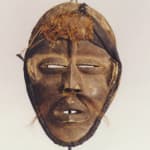Wobe Wooden Mask, 19th Century CE - 20th Century CE
Wood
7.375 x 11
PF.4477
The We people, which included the Wobe and Gere tribes, believe in a world that is divided into two distinct realms; the village, on the one hand, which includes inhabitants...
The We people, which included the Wobe and Gere tribes, believe in a world that is divided into two distinct realms; the village, on the one hand, which includes inhabitants and human-made utensils; and the other realm of the forest with its wild animals, bon spirits and fields. In order to communicate with the ethereal world of spirits, masks were made as physical intermediaries between flesh and incorporeal beings. The mask acted as a sort of conduit, a device that communicated feelings, especially during the highly emotionally charged rituals of dance.
A mask such as this fascinating example incarnates a supernatural force, or gle, who lives in the forest and wishes to participate in village life. Because the spirit is invisible it must appear in a recognizable form and establish its own unique character. This particular persona would be communicated through a dream to a male initiate who will then describe the design the mask should have to his village elders. It is up to them to decide whether or not a mask should be made. This method creates a unique object with individualistic qualities. Here we see a very realistic mask with moustache, penetrating eyes and finely woven band around the chin. Its expression projects wonderment and a sense of otherwordly detachment, while still being deeply in touch with reality. Through a sculptor's vision we have a visual record of Wobe life - with its magnificent festivals, dances, and pageantry, opening a door into the mysteries of another world.
A mask such as this fascinating example incarnates a supernatural force, or gle, who lives in the forest and wishes to participate in village life. Because the spirit is invisible it must appear in a recognizable form and establish its own unique character. This particular persona would be communicated through a dream to a male initiate who will then describe the design the mask should have to his village elders. It is up to them to decide whether or not a mask should be made. This method creates a unique object with individualistic qualities. Here we see a very realistic mask with moustache, penetrating eyes and finely woven band around the chin. Its expression projects wonderment and a sense of otherwordly detachment, while still being deeply in touch with reality. Through a sculptor's vision we have a visual record of Wobe life - with its magnificent festivals, dances, and pageantry, opening a door into the mysteries of another world.



